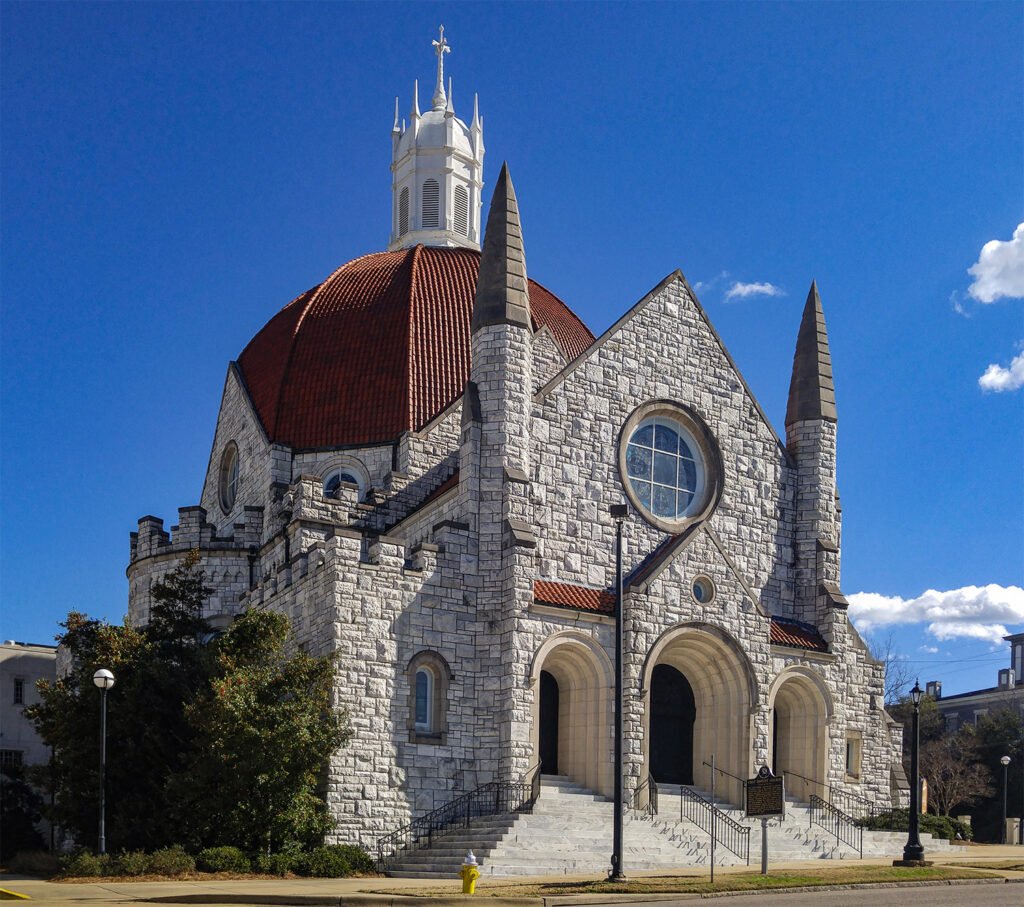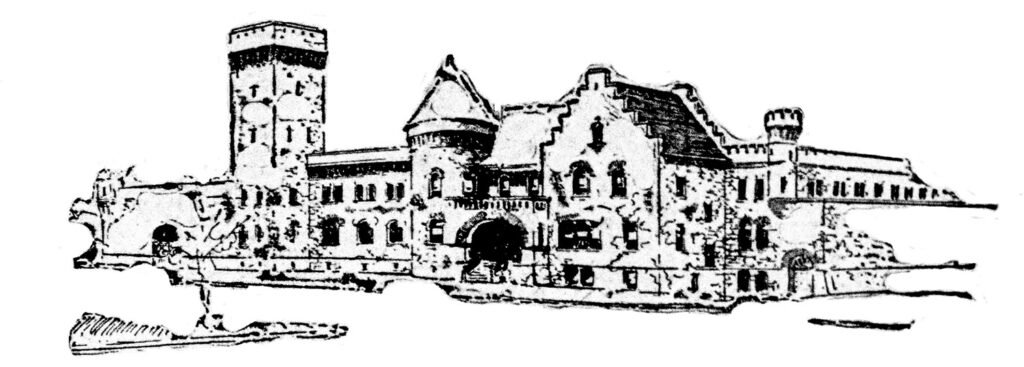
Category: Architecture
-
William R. Cannon Chapel and Religious Center, Emory University – Atlanta (1981)

William R. Cannon Chapel and Religious Center at Emory University – Atlanta (1981) – designed by Paul Rudolph -

In the Words of G.L. Norrman: On Music Critics (1899)
The background: Following G.L. Norrman‘s published remarks about Moriz Rosenthal, The Atlanta Journal received several indignant letters rebuking his criticism. Rosenthal then held a second concert in Atlanta, which was attended by a reader of the newspaper, identified only as “M.E.C.”
In a letter published on February 24, 1899, “M.E.C.” gave a rapturous review of the concert in ridiculously florid terms, while also swiping at Norrman. The pertinent quotes:
- “But why should we expect every artist to have in the highest degree every attribute of other artists: A man may be an excellent architect, and yet know very little about music.”
- “I had occasion several weeks ago to refer with indignation to the kind of stuff a morning paper was serving us as musical criticism.”
Always eager to have the last word, Norrman shot back with another letter, which was published on February 27, 1899. Norrman liberally quoted M.E.C.’s own words, and also took the opportunity to mock the Christian Science movement — keep in mind, he was still overseeing the construction of Atlanta’s Christian Science church at the time.
It’s probable that “M.E.C.” was Sue Harper Mims, the leader of Atlanta’s Christian Science church, a stuffy old society woman with whom Norrman regularly traded barbs.
Norrman’s remarks:
To the Editor ofThe Journal:
“I never realized until Friday, when reading the criticism on Rosenthal by “M.E.C.” the amount of delicate perception that is necessary to be a musical critic. It requires such a delicacy of perception as to be able to distinguish a half expressed passion from an expressed passion, or from an unexpressed passion. A critic who can comprehend the “half expressed passion of a Chopin” can undoubtedly comprehend “the intellectual profundity of Schumann.” A person who is endowed with such spiritual light might almost be capable of preaching a Christian Science sermon or write poetry for a young ladies’ literary society.
To an ordinary person whose spiritual understanding does not extend beyond what is expressed, music, architecture or any other art is a fine art only when it is a vehicle for conveying emotions. When art is used for any other purpose it is merely a handicraft. So an acrobatic performance with the fingers on a piano is itself no more of a fine art than is an acrobatic performance with the toes on a tight rope.”
G.L. NORRMAN
-

In the Words of G.L. Norrman: On Music Criticism (1899)
G.L. Norrman was a man of forceful and contrary opinions that often riled the ruling class of Atlanta, a pretentious pack of lying dullards who couldn’t face the truth if their lives depended on it.
What no doubt baffled them the most about Norrman was that he could fully articulate his objections in a defined and intelligent manner of which most people are simply incapable.
In February 1899, the Atlanta Concert Association hosted a concert at Degive’s Grand Opera House by the Polish pianist Moriz Rosenthal, who was popularly referred to by his last name only.
Rosenthal was internationally famous, and his appearance in a backwater like Atlanta was considered a cultural milestone for the city.
The newspapers were expectedly fawning of Rosenthal’s performance, but a reporter from The Atlanta Journal got an earful when he asked Norrman for his thoughts on Rosenthal, which were published on February 17, 1899, in the “Loitering in the Lobbies” column.
The comments include multiple references to 19th-century performers, and appropriate informational links have been provided. However, there is scant information online about Joseph Denck (1848-1916), a pianist from Columbia, South Carolina who primarily performed in the Southeast.
Norrman’s remarks:
“Yes, I heard Rosenthal, and while I do not profess to be a musical critic I don’t mind saying how he impressed me.
I think his technique was very good—but that his selections were poor. I am backed up by an Atlanta musician who is far above the average, in fact, almost a professional. You see, Rosenthal played last night nothing that is familiar even to the average musician much less the great body of his audience. Indeed, as a popular success his entertainment was a dead failure. Now, if he had played a few selections even from such composers as Rossini, Beethoven, Wagner, I could have followed him much better. But, as it was, I could hardly follow him at all—and, of course, the great body of his auditors could not enjoy his playing.
It would have been far better if he had played selections from composers more familiar to people of average musical culture and thrown in popular airs for the benefit of the great majority of his audience who could have understood them. As it was these people simply sat there got nothing for their money.
Perhaps there were a dozen or so persons in the audience who really enjoyed the performance. Still I couldn’t prove even this. If the bringing of Rosenthal here was to arouse an interest in music and help the people to understand it, I can’t see exactly how this object was accomplished.
Say, for instance, that the majority of his hearers were up in the multiplication table of music, so to express it, and I am satisfied that such was not the case—how could they even then be expected to make a long leap and understand and enjoy the calculus of music he undoubtedly gave. For his selections were all of the highest, the most difficult grade, ultra scientific and classical.
So, in my view, his performance was not only a failure from a popular standpoint, and was not even a success judged from the plans of average and even above the average musicians and people of musical culture.
For my own part, I much prefer Mr. Joseph Denck as he played a few years ago. He has a marvelous touch and always played selections from composers more or less familiar to music lovers, and his playing of popular music is exquisite. Yes, as Denck played a few years ago, when I last heard him. I like him better than Rosenthal. He is not only a wonderful pianist, but knows how to please the average musicians and the people better than Rosenthal, judged by his performance last night.”
Reporter: How does Rosenthal compare with Padarewski?
“He’s about as good, I think. I never thought Paderewski such a miracle of a musical genius as some people did. I saw nothing about him to lose my head over. He’s very fine, no doubt, but so is Rosenthal, I suppose—
But admit that Rosenthal was as fine as fine can be Wednesday night. What does it amount to him if we cannot follow him?
It is not good taste in a pianist to be ever so fine if his audience don’t know it—can’t take in his fineness. Just as it would not be good taste for a person to speak Greek in a parlor full of people if nobody present understood the language.
I am no musical critic, but I try to take a common sense view of Rosenthal, and am backed up in what I have said by a musician of far more than average ability in musical matters. We were discussing Rosenthal after his performance and found that our views coincided concerning his recital.”
-
Greensboro-Guilford County Government Center – Greensboro, North Carolina (1972)
-

In the Words of G.L. Norrman: On Kissing, Again (1898)
The background: Attitudes toward sex were rapidly changing in the late 19th century, and 1898 was a banner year for kissing controversies.
Richmond P. Hobson was a dashingly handsome Navy lieutenant from Alabama who became a national celebrity when he was captured and held as a prisoner of war after sinking the Merrimac steamship in the Spanish-American War.
Following his release, Hobson went on a national tour, which was attended by throngs of admiring young girls, and in August 1898 he stopped in Atlanta to give a speech, which Norrman apparently attended.
A week after his Atlanta visit, Hobson visited Long Beach, California, where he was approached by Emma Arnold of St. Louis, visiting with a group of a dozen friends. Arnold brazenly asked Hobson for a kiss — to which he agreed. Arnold then proceeded to kiss each of her female friends to share Hobson’s kiss with them.
The resulting scandal fueled a press flurry that lasted for months, and it launched Hobson’s status as an early sex symbol. Hobson kissed hundreds of girls for the remainder of his tour, which newspapers began dubbing “Hobson’s kissing campaign” — at one event alone in Chicago, he reportedly kissed 163 women.
As controversy swirled over Hobson’s incident with “the Long Beach girl”, Norrman wrote the following letter to The Atlanta Constitution, which was published on August 14, 1898.
“Patriotism and Kisses”
“Editor Constitution—
Lieutenant Hobson, in a short talk at the governor’s mansion, remarked to the effect that too much ado was made over the incident of the Merrimac, claiming that all our seamen would cheerfully embrace every opportunity of serving the country.
From Miss Arnold’s explanation of the incident of the kiss I infer that she is equally modest and generous and gives every girl in the country credit for a desire of embracing the same opportunity of showing, with a merry smack, her appreciation of the heroism on the Merrimac.”
G.L. Norrman
Atlanta, August 12th.
-

In the Words of G.L. Norrman: On Cursing (1898)
The background: In 1898, Randolph Guggenheimer, president of the City Council of Greater New York, instituted an ordinance that prohibited swearing in public places. Imposing a $10 fine on a person for each curse word they uttered, the law was widely mocked in the national press, and the council repealed it in less than a month.
On August 2, 1898, The Atlanta Journal published the opinions of well-known Atlantans on New York’s “anti-damn” law and whether it could be replicated in Atlanta, in an article titled ‘”Antidmamn” Law For Us?” Norrman — once a sailor, mind you — was naturally opposed.
As a representative piece of Atlanta journalism, the article repeatedly misspelled Guggenheimer’s name as “Gurgenheimer”.
Norrman’s remarks:
“Curse words I regard merely as adjectives used to express strong feeling. They simply emphasize what a man says and those toward whom they are applied always understand that what is said is meant. These adjectives are sometimes very useful in business, because some people persist in refusing to understand what you mean unless you emphasize it with them. These adjectives should be regulated arccording to the people with whom you are talking.
To illustrate: If a lady comes into the office and proves to be disagreeable, I simply excuse myself—say that I am too busy, or words to that effect: but if a book agent or lightning rod man or life insurance drummer comes in, I tell him to go to hell. I don’t believe that Mr. Gurgenheimer’s [sic] law can be enforced to advantage in New York City. My experience with New Yorkers is that you often have to emphasize your language very emphatically in talking even to them. In fact, I believe that more emphasis is needed in New York than Atlanta because it’s a larger place. Of course, I don’t think, for a moment that the ‘anti-damn’ laws could be enforced in Atlanta. Its enforcement would seriously interfere with business.
I admit that these adjectives are not elegant, but they form the most forcible way in which one can express himself.
-

In the Words of G.L. Norrman: On Kissing (1898)
The background: In February 1898, The Atlanta Journal received a letter from an old society lady of Atlanta, Mrs. Kingsberry, who was disturbed by “the latest fad in the Gate City=kissing”. Repeating 2 rumors she had recently heard about Atlanta girls allowing boys to kiss them, Mrs. Kingsberry wrote: “This fad of kissing is simply horrid!”
The letter was widely distributed and mocked in newspapers across the country, leading the Journal to ask prominent Atlanta citizens for their own opinions on kissing, which were published in a February 8, 1898 article titled “Is There a Kissing Craze? And If So, What About It?” Always good for a quip, G.L. Norrman offered his own kissing commentary.
Norrman’s remarks:
“Judging from my own experience, there is not much kissing going on in Atlanta. I stand in with the young ladies pretty well, but they never give me any chance at it, so I believe The Journal‘s correspondent is wrong in her opinion about Atlanta society. If the lady who made these statements will give me some pointers, I will investigate the matter, and if she is right I will be able later to tell you something about it.”
“Abroad they are very strict in the highest society. I find that the world is the same everywhere in the same social circles. It was common among the Romans to kiss a lady to tell whether she had been drinking. They had such an abhorrence of drinking, especially among women, that it was customary to salute the women to make sure that they had not been drinking. As the origin of kissing, I cannot speak advisedly. They tell me that it is a very good thing, and may have originated with Adam and Eve, so far as I know.”
-
In the Words of G.L. Norrman: On His Return Visit to Europe (1897)
The background: In 1897, G.L. Norrman took a 5-month trip to Europe, returning to the continent for the first time since he emigrated to the United States in 1874. Naturally, The Atlanta Journal published an account of his observations in a December 9, 1897, article titled “Unique View of Old World”.
In speaking about England, Norrman references Lady Somerset, the leader of the British temperance movement, who he accused of slumming, a distinctly 19th-century pastime in which the wealthy found it fashionable to tour the impoverished areas of cities to sate their morbid curiosities.
Norrman was appalled to find women invading England’s saloons, quoting Alexander Pope, the English poet, from his poem Essay on Man, Epistle II for a warning on the dangers of “sentimentality”. Here, he also took the opportunity to comment on protective tariffs that had been imposed by the United States in 1897 — Norrman was not a supporter.
Norrman’s thoughts on European architecture and history (a characteristic quip: “a great deal of Roman history is merely romance”) were expounded on further in his 1898 pamphlet, Architecture as Illustrative of Religious Belief.

First Baptist Church – Montgomery, Alabama (1905-16) – designed by G.L. Norrman Norrman’s remarks:
“England, I could see, is not doing well. I was struck by existing conditions in London. There is more drunkenness there than in any other city I visited. In fact, I saw more drunkeness in England than in any other country. It seems that since Lady Sommerset [sic] has made slumming fashionable, all the women of England have gone slumming. I have seen more drunken women in England than in any other country. There they might sing the song, “Dear Mother, Come Home,” instead of “Dear Father, Come Home“. It is as common a sight to see women in saloons in London as it is to see men in our American saloons. I have often passed barrrooms and seen as many as half a dozen women standing at the counter. Twenty years ago, when I was in England, the common women of the worst streets seemed not as brazen as the well dressed women one sees on the principal streets today.
Sentimentality is running rampant in England, and when sentimentality goes wild it does more harm than all the vices put together that human frailty is heir to.
“Vice is a monster of such frightful mein,
As to be hated needs but to be seen;
Yet seen too oft, familiar with her face,
We first endure, then pity, then embrace.”Where there is no morality society begins to break down. In England disintegration of society is noticeable everywhere. There seems to be a feeling in the air there that the people are expecting something to turn up, they don’t know what.
Their social system is based on hypocrisy and cant.
I made considerable investigation along historical lines while in Europe, and am led to believe that a great deal of Roman history is merely romance. I base this opinion on the the fact that no picture of any kind, either painted, modeled or carved, can be found which illustrates any of the cruelties we read of. A people with slaves who were such great picture makers would surely have been put on record through the medium of their art, if the cruel practices of their masters had really occurred. I feel quite sure that if historians had understood architecture, ancient history would have read quite differently from what it does.
In the transmission of history, language is very unreliable whenever metaphors are used. For instance, if in 2,000 years from now a newspaper should be found stating that the police commissioners had cut the head off of the chief, the reader would naturally think that there were very bloodthirsty police commissioners in those days.
In making a study and investigation of ancient architecture I found that there are no crucifixes of any description before the fifth century. The earliest that can be found are in the Bysantin style and could not have been made before there was a Bysantin style, which was about 500 years after Christ is supposed to have lived.
In business prosperity the countries of Europe seem to be doing well, with the exception of England, as I have already stated. There is a great deal of improvement going on in Italy. There is as much building going on in Rome as in New York. Many blocks of old Roman buildings are being torn down and fine boulevards are being laid out. All of the blocks of houses in front of St. Peter’s cathedral have been condmened and it is intended to open a large boulevard from the church to the river. This will give a splendid view of the cathedral. Hitherto it has been obscured by the many houses around it.
The European countries seem to have the highest regard and admiration for the United States. I heard no adverse criticisms in regard to the policy of our government except in reference to the protective tariff. The people of Europe do not like this feature in our policy, and it is the occasion of considerable unfavorable comment among all the countries I visited. For my own part I think the protective tariff is a mistake. It produces an uncalled for antagonism, because from what I saw of American exhibits in Brussels, London and Stockholm, America can beat the world in all kinds of goods that are made by machinery in regard to both price and quantity. While it is true that European laborers do not get as much as American laborers it is also true that American laborers can do about three times as much as European laborers. I know that it is so in regard to building and I presume it is so in all other lines also. The cost of building per cubic foot is greater in Europe than here, notwithstanding that labor is much cheaper.
There is a great deal of building going on in Vienna and Stockholm. The style of the architecture in these places I liked very much. The old German style of architecture in Vienna I found to show a high form of art. But I believe that I liked the Roman styles better than those of any other city or country that I visited.
As to the result of my trip to Europe, it depends on from what standpoint it is viewed. In regard to keeping the rain out of a building, I have no new information, but as to the meaning of architecture, I have learned a good deal. I have especially given attention to the meaning of the forms used in Romanesque architecture.
-
In the Words of G.L. Norrman: On Sam Jones, Evangelist (1897)
The background: Sam Jones was a Methodist minister from the backwoods of northwest Georgia who traversed the United States in the late 19th and early 20th centuries, spreading a populist gospel of hellfire and hatred that Americans still lap up like manna.
Notorious for his caustic and crude demeanor, Jones was a reformed alcoholic who railed against gambling, dancing, theater-going, Europeans, Chinese immigrants, and women doing damn near anything besides dutifully serving their husbands (“You old woman at the club meeting while your husband is choking down cold meat at home—there’s a special punishment for you”, he told a crowd at Atlanta’s Trinity Methodist Church.). Naturally, Jones was a staunch Prohibitionist.
Jones was popular in Atlanta — among a certain element, anyway — and in 1896, he became a regular contributor to The Atlanta Journal, writing weekly diatribes about society, politics, and whatever else drew his ire, composed in an exaggerated folksy style that included frequent reference to the devil and Jones’ cadre of cronies, among them a fellow Methodist minister named George Stuart — always referred to as “Brother Stuart”.
In early 1897, Jones and Brother Stuart held weeks-long revivals in Boston and Nashville, raking in thousands of souls and, of course, plenty of tithes and offerings. In Boston, Jones publicly rebuked the city’s wicked nightlife: “Some of you fellows who go to bed at 9 o’clock don’t know what is going on here in Boston. The devil doesn’t start his procession until 11 o’clock,” he explained.
Meanwhile, the January 27, 1897 issue of the Journal published a gushing article in which the reporter interviewed Jones while he was conducting a “midnight tour” of Boston’s Chinatown with his entourage of men, including Brother Stuart. The tour concluded with a visit to an “opium joint”, although the reporter was careful to note that Jones and his men were smoking “…not opium, just plain every-day Havana-de-Kentuckio tobacco.”
During his February 1897 revival in Nashville, Jones wrote to the Journal about the gambling problem in that most sinful city:
“I said, in a sermon a day or two ago that if ten greasy old n*****s were to congregate in a back alley in Nashville and play cards for an old tin syrup pitcher, the police would run them in jail for gambling, and yet, the deacons and stewards and elders with their invited guests play cards for a cut glass vase in their elegant parlors, with the whole list of names published in the papers the next morning, telling who won the vase, and yet, nothing is done.”
Jones was scheduled for a 2-week stint in Atlanta in March 1897, and on February 19, 1897, the Journal published a letter from G.L. Norrman sharing his thoughts on the matter. Witty and urbane, Norrman was Jones’s antithesis: a European immigrant, patron of the theater, and an avowed anti-Prohibitionist.
In this letter are Norrman’s earliest published remarks mocking the business of 19th-century Christianity — a subject he would expound upon in his 1898 pamphlet, Architecture As Illustrative of Religious Belief, in which he revealed himself to be a worshipper of the gods of Old Norse mythology.
Here Norrman lampooned Jones’ characteristic writing style, throwing in several hick phrases and even mentioning Brother Stuart, although he misspelled his name as “Stewart”. There’s no question that G.L. Norrman could be harsh and condescending in his criticisms, but dear God, in a circus full of such absurdity, someone has to be.
Norrman’s assessment of Sam Jones didn’t seem to hurt his reputation too much, even with Methodists — a few months later he began designing the new Methodist church in nearby Decatur, Georgia.

Anderson Memorial Methodist Episcopal Church – Decatur, Georgia (1899) – designed by G.L. Norrman Norrman’s remarks:
To the Editor of the Journal:
“The revival of Mr. Sam Jones is billed to be here on March 7th, and will be the greatest attraction of the season. He promises that “it shall be as full of spirit and fight as all his meetings have been.”
He says he “will run the black flag against the flesh, the world and the devil.” But the main point of the performance will be to “give the devil a black eye.” And if the devil “winks the other eye,” he will blacken that also.
Mr. Jones thinks it would be well for the good people to invite the Lord to help him with his revival, but if the Lord should not accept the invitation, he will beat the devil by himself, with Brother Stewart to help him, and I infer from Mr. Jones’ letter that the devil has a poor show when Brother Stewart is around.
According to Mr. Jones’ philosophy, there is a great deal of business and pleasure carried on successfully to which the Lord is very much opposed; from which fact it would seem that the Lord does not cut much of a figure in the world anyway.
Mr. Jones is working away very hard at present on the devil’s tail, and he says he is getting along tiptop, only he is afraid he will not finish the job before he has to come here to blacken the devil’s eyes.
By the time Mr. Jones gets through with blackening the devil’s eyes and cutting of his tail, the poor devil will be pretty badly used up, so that any ordinary minister can handle him afterwards.
The posters necessary to illustrate the show have not been put up yet, except Mr. Jones’ own picture, but no time or attention has been spared to get up the paraphernalia and accessories necessary for a first class revival.
Both the animals and people connected with the show are in good trim and in ecstacies over the prospect of the performance. The “Yaller dog” is wagging his tail, and the “Flop-eared hound” is barking with joy.
The “Dude” is happy and is strutting about with the air of a peacock, and the “Dudine” is chipper as a cricket. The “Tough barroom bum” got on a spree at the last revival and has not sobered up yet, but his good and dutiful wife is bathing his head, so it is hoped he will be in proper trim by next month.
The tough “Bum preacher” is in good condition. Both the “Soulsaving business” and the horse-swapping business have been profitable, so his folks are all having a high old time.
Prof. Excell has a new band wagon and his two lady assistants are too lovely for anything, and are tuning up like nightingales. In fact nothing has been spared to make the revival a success, so I feel justified in vouching for Mr. Jones’ promise to give sin and sinners an interesting time.
G.L. NORRMAN
-
In the Words of G.L. Norrman: On “A Model Jail”, Again (1896)

Illustration of G.L. Norrman’s 1892 design for the Fulton County Jail. “Fulton County’s New Jail”, The Atlanta Journal, August 27, 1892, p. 1. The background: Following the publication of G.L. Norrman‘s previous letter about the “model jail”, The Atlanta Journal solicited a response from Forrest Adair of the Fulton County Commission.
“I have not read Mr. Norrman’s card and do not intend to,” Adair claimed, adding: “The plans are not submitted for his approval and it is not desired.” Adair referenced Norrman’s harsh criticism of the Boys High School designs by GoLucke & Stewart, and also noted that Norrman was “very caustic in his criticism” of Bradford L. Gilbert, another sham architect who designed the Cotton States Exposition and English-American Building in Atlanta.
“I do not suppose Mr. Gilbert is losing any sleep over it”, Adair remarked, concluding that: “It seems to be a habit of Mr. Norrman’s and I do not see that we need to worry about his criticism in this case.”
In response, Norrman wrote another letter to the Journal, published on November 24, 1896, in an article titled “The Lively Jail Question”. Here Norrman admitted to his remarks on Gilbert, and alluded to his precarious financial state at the time, mentioning almost offhandedly that property he owned was being sold for taxes.
Indeed, Atlanta and the Southeast were in the throes of the Panic of 1896, and an undeveloped lot that Norrman had previously purchased in Inman Park was sold by the city marshal that same month for delinquent taxes.
“There are a great many beside myself in that fix”, Norrman stated, and he wasn’t wrong: a listing of properties sold for taxes in November 1896 spanned 11 pages in the Journal.
Norrman mocked Adair as “the supreme and mighty ruler of the county” and insinuated that his future political chances might be in jeopardy, but Adair — one of the most wealthy and influential men in Atlanta’s history — was re-elected to the county commission the following year.
Wilkins’ jail was completed in fall 1898, with the total cost exceeding $200,000. Jail officials began immediately complaining about its poor design and shoddy construction quality, and just weeks after opening, 4 prisoners escaped from the structure.
Adair and the county commissioners blamed the jailbreak on the sheriff, John W. Nelms, who in turn blamed the jail’s design, noting that there had never been an escape from the old facility.
“The jail is built something on the order of a hotel”, Nelms complained to The Atlanta Journal. “It is scattered over a large area, and in such a way that even with a guard to work every floor there is time for prisoners to work.”
Needless to say, Norrman’s objections were valid.
Norrman’s remarks:
To the Editor ofThe Journal.
My business is not only that of an architect, but also that of an architectural critic, and I am so taken and accepted by all thorough and regularly educated architects, as well as by people of culture in general.
Besides the criticism which Mr. Adair refers to, I have written many others. Sometimes I write because I am paid for it, sometimes because I think it will be interesting to my profession to know what is going on, sometimes I write because it is interesting to myself.
My reason for writing a description of “A Model Jail” in Saturday’s Journal was the very apathy which Mr. Adair speaks of, from which I think that he and everyone connected with the erection of the new jail should be aroused.
For a set of men who are entrusted with public funds to spend them so recklessly and carelessly, even if there is no individual gain at the bottom of it, and “lose no sleep over the matter” is not fair to the taxpayers of the county. Those whose property is being sold for taxes, and there are a great many beside myself in that fix, lose a great deal of sleep over the matter.
I know perfectly well that Mr. Adair is the supreme and mighty ruler of the county, and there is no way of stopping the erection of such an expensive monstrosity as the “Model Jail,” unless the grand jury takes a hand in the matter (in which case Mr. Wilkins will have no “merit” to stand on).
While Mr. Adair is not losing any sleep over the matter now, he may when the next election comes round, and I think that the people who are sold out for taxes will be awake also.
Those who are not familiar with architecture could not possibly know how badly they are taken in unless their attention is called to it by some architect, so I hope you will pardon me for taking up so much of your valuable space about this matter.
G.L. NORRMAN


